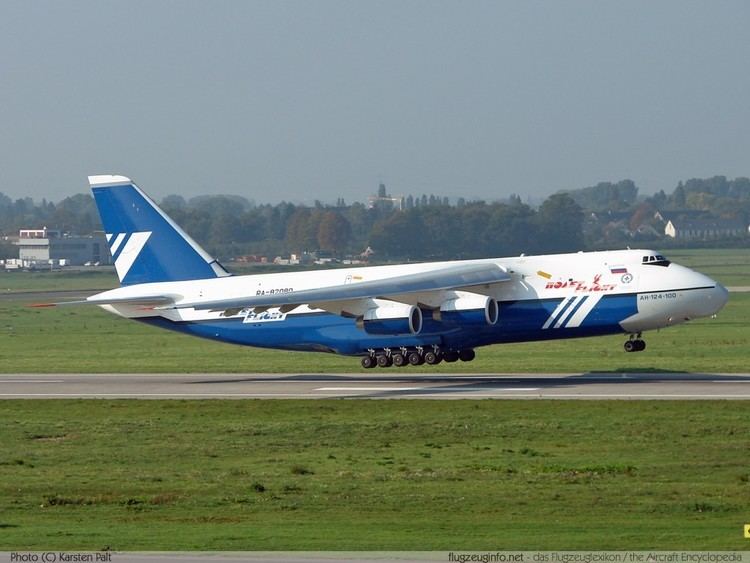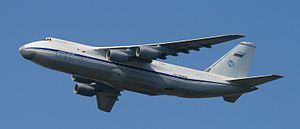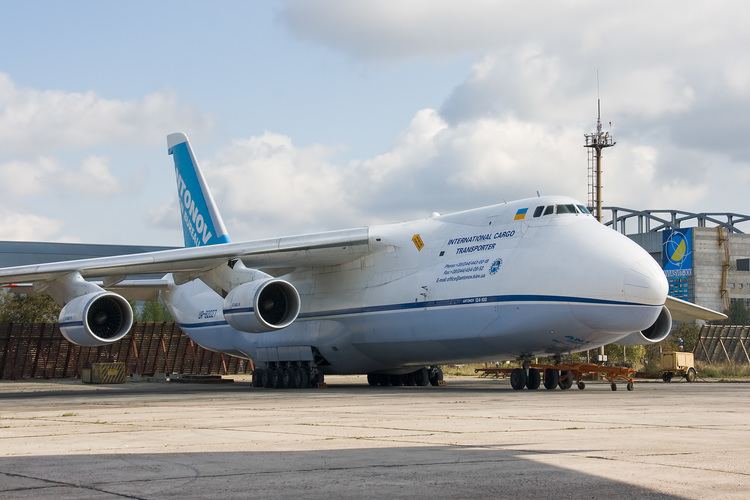Wingspan 73 m Introduced 1986 | Length 69 m Engine type Turbofan | |
 | ||
Unit cost 70,000,000–100,000,000 USD | ||
The Antonov An-124 Ruslan (Ukrainian: Антонов Ан-124 "Руслан") (NATO reporting name: Condor) is a strategic airlift jet aircraft. It was designed by the Antonov design bureau in the Ukrainian SSR, then part of the Soviet Union (USSR). Until the Boeing 747-8F, the An-124 was, for thirty years, the world's highest aircraft gross weight production cargo airplane and second heaviest operating cargo aircraft, behind the one-off Antonov An-225 (a greatly enlarged design based on the An-124). The An-124 remains the largest military transport aircraft in the world.
Contents
- Antonov an 124 ruslan loading and unloading nakl d n a vykl d n panduru dny nato days 2013
- Development
- Design
- Operational history
- Significant activities
- Variants
- Military
- Former military operators
- Civil
- Former civil operators
- Notable accidents
- Specifications An 124 100M 150
- Flight range
- References

During development it was known as Izdeliye 400 (Product #400) in house, and An-40 in the West. First flown in 1982, civil certification was issued on 30 December 1992. In July 2013, 26 An-124s were in commercial service with 10 on order. In August 2014, it was reported that Antonov An-124 production was stopped due to the ongoing political tensions between Russia and Ukraine. The various operators of the An-124 are in discussions with respect to the continuing airworthiness certification of the individual An-124 planes. The original designer of the An-124 is responsible for managing the certification process for its own products, but Russian/Ukrainian conflicts are making this process difficult to manage. Military operators are able to self-certify the airworthiness of their own aircraft, but Russian civil operators must find a credible outside authority for certification if Ukraine is unable to participate in the process.

Antonov an 124 ruslan loading and unloading nakl d n a vykl d n panduru dny nato days 2013
Development

During the 1970s, the Military Transport Aviation (Komandovaniye voyenno-transportnoy aviatsii or VTA) arm of the Soviet Air Forces had a shortfall in strategic heavy airlift capacity. Its largest planes consisted of about 50 Antonov An-22 turboprops, which were used heavily for tactical roles. A classified 1975 CIA analysis concluded that the USSR did "...not match the US in ability to provide long-range heavy lift support."

The An-124 was manufactured in parallel by two plants: the Russian company Aviastar-SP (ex. Ulyanovsk Aviation Industrial Complex) and by the Kyiv Aviation Plant AVIANT, in Ukraine. Design work started in 1971 and construction of facilities began in 1973. Manufacturing on the first airframe began in 1979. Ultimately this project brought together over 100 factories contracted to produce systems and parts.

The first flight took place in December 1982 and the first exposure to the West followed in 1985 at the Paris Air Show.
Russia and Ukraine agreed to resume the production in the third quarter of 2008. In May 2008, a new variant—the An-124-150—was announced; it featured several improvements, including a maximum lift capacity of 150 tonnes. However, in May 2009, Antonov's partner, the Russian United Aircraft Corporation announced it did not plan production of An-124s in the period 2009–2012. In late 2009, Russian President Dmitry Medvedev ordered production of the aircraft resumed. It is expected that Russia will purchase 20 new aircraft. In August 2014, Jane's reported that, Russian Deputy Minister of Industry and Trade Yuri Slusar announced that Antonov An-124 production was stopped due to ongoing political tensions between Russia and Ukraine.
Design
Externally, the An-124 is similar to the American Lockheed C-5 Galaxy, having a double fuselage to allow for a rear cargo door (on the lower fuselage) that can open in flight without affecting structural integrity. It is slightly shorter, with a slightly greater wingspan, and a 25% larger payload. Instead of the Galaxy's T-tail, the An-124 uses a conventional empennage, similar in design to that of the Boeing 747.
The aircraft uses oleo strut suspension for its 24 wheels. The suspension has been calibrated to allow landing on rough terrain and is able to kneel to allow easier front loading. The plane has an onboard overhead crane capable of lifting up to 30 tonnes of cargo, and items up to 120 tonnes can be winched on board.
Up to 150 tonnes (150 long tons; 170 short tons) of cargo can be carried in a military An-124; it can also carry 88 passengers in an upper deck behind the wing centre section. The cargo compartment of An-124 is 36×6.4×4.4 m (118×21×14 ft), ca. 20% larger than the main cargo compartment of C-5 Galaxy, which is 36.91×5.79×4.09 m (121.1×19.0×13.4 ft). Due to limited pressurisation in the main cargo compartment (24.6 kPa, 3.57 psi), it seldom carries paratroopers.
Pilots have stated that the An-124 is light on the controls and easy to handle for an aircraft of its size.
Some airports require pavement protection from the heat and blast effects of the An-124's auxiliary power unit.
Operational history
Germany led the recent effort to lease An-124s for NATO strategic airlift requirements. Two aircraft are leased from SALIS GmbH as a stopgap until the Airbus A400M is available. Under NATO SALIS programme NAMSA is chartering six An-124-100 transport aircraft. According to the contract An-124-100s of Antonov Airlines and Volga-Dnepr are used within the limits of NATO SALIS programme to transport cargo by requests of 18 countries: Belgium, Hungary, Greece, Denmark, Canada, Luxembourg, Netherlands, Norway, United Kingdom, Poland, Portugal, Slovakia, Slovenia, Finland, France, Germany, Czech Republic and Sweden. Two An-124-100s are constantly based on full-time charter in the Leipzig/Halle airport, but the contract specifies that if necessary, two more aircraft will be provided on six days notice and another two on nine days notice. The aircraft proved extremely useful for NATO especially with ongoing operations in Iraq and Afghanistan.
United Launch Alliance (ULA) contracts the An-124 to transport the Atlas V launch vehicle from its facilities in Decatur, Alabama to Cape Canaveral. ULA also uses the An-124 to transport the Atlas V launch vehicle and Centaur upper stage from their manufacturing facility in Denver, Colorado to Cape Canaveral and Vandenberg Air Force Base. Two flights are required to transfer each launch vehicle (one for the Atlas V main booster stage and another for the Centaur upper stage). It is also contracted by Space Systems Loral to transport satellites from Palo Alto, CA to the Arianespace spaceport in Kourou, French Guiana.
Airbus Transport International, a subsidiary of Airbus, has selected another Russian cargo company, Polet Airlines as "designated carrier" to the company. Polet expects its three An-124-100s will transport astronautic equipment manufactured by EADS, which is Airbus' parent company, and components of the Airbus A380 superjumbo.
As of 2013 the An-124 has visited 768 airports in over 100 countries.
Significant activities
Variants
Military
Former military operators
Civil
In July 2013, 26 An-124s were in commercial service.
Former civil operators
Notable accidents
As of November 2016, four An-124 hull-loss accidents have been recorded, with a total of 97 fatalities:
Specifications (An-124-100M-150)
Data from Antonov
General characteristics
Performance
